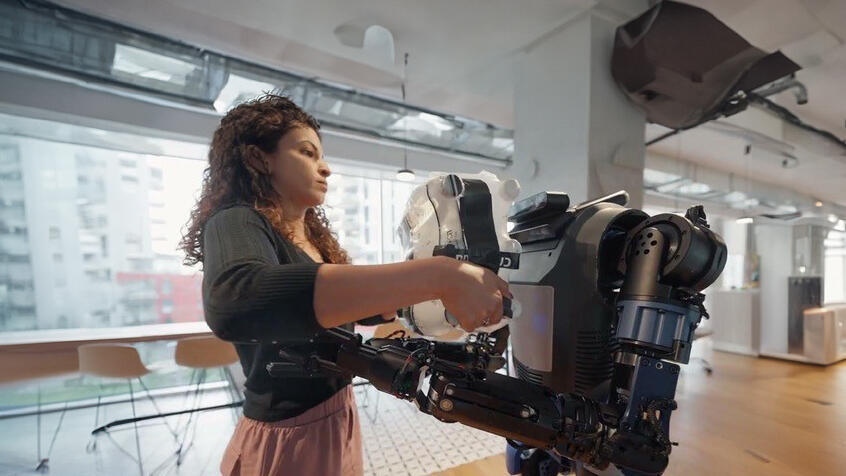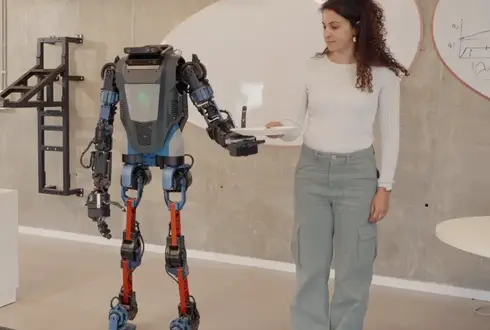
There’s a new humanoid in town: How does Amnon Shashua's MenteeBot stack up against the competition?
Mentee Robotics, which has raised $17 million to date, was founded in 2022 by Prof. Amnon Shashua, the founder of Mobileye, Prof. Lior Wolf, formerly a research scientist and director at Facebook AI Research, and Prof. Shai Shalev-Shwartz, a world-renowned computer scientist and machine learning researcher. The production-ready prototype is expected to be deployed by Q1 2025 and will be powered by camera-only sensing, proprietary electric motors that support unprecedented dexterity, and fully integrated AI.
This is an ancient dream that has accompanied science and ignited the imagination since the dawn of humanity: a humanoid robot capable of obeying human commands. Greek, Chinese, and Egyptian philosophers in antiquity discussed it. Leonardo da Vinci attempted to make it a reality, and Elon Musk is still striving to achieve it. However, now, Prof. Amnon Shashua, one of the most prolific scientists and entrepreneurs in Israel, is confident that he has succeeded in solving the problem.
After approximately two years in stealth mode, Shashua unveiled the MenteeBot on Wednesday, a humanoid robot based on artificial intelligence (AI) capabilities that can perform a complete cycle of actions - from a verbal command in natural language to the completion of complex tasks involving navigation and movement in space, understanding context, identifying objects, and the ability to move them from place to place. Nevertheless, the demonstration of the capabilities provided by Shashua's company is far from impressive, and the road to commercial implementation seems complex.
The robot is being developed by Mentee Robotics, founded in 2022 by Prof. Amnon Shashua, the founder of Mobileye, Prof. Lior Wolf (CEO), formerly a research scientist and director at Facebook AI Research, and Prof. Shai Shalev-Shwartz, a world-renowned computer scientist and machine learning researcher. Shashua serves as the chairman of Mentee Robotics. To date, $17 million has been invested in the company by Ahren Innovation Capital and other investors.
“We are on the cusp of a convergence of computer vision, natural language understanding, strong and detailed simulators, and methodologies on and for transferring from simulation to the real world,” said Prof. Amnon Shashua, chairman of Mentee Robotics. “At Mentee Robotics we see this convergence as the starting point for designing the future general-purpose bi-pedal robot that can move everywhere (as a human) with the brains to perform household tasks and learn through imitation tasks it was not previously trained for.”
Technology companies have been attempting to develop humanoid robots for decades, with prominent players in the current period including Elon Musk's Tesla (developing Optimus) and the veteran Boston Dynamics. Another significant player is Figure, whose scientists include graduates of Tesla and Boston Dynamics, unveiling an autonomous humanoid robot called Figure 01 a year ago.
In terms of physical abilities, there is seemingly no essential difference between the MenteeBot and its competitors. Like them, it is capable of walking (albeit not very quickly) and performing everyday actions such as placing objects in a box, lifting the box, and moving it to another location. According to the company, MenteeBot differs from its competitors in its ability to understand instructions in natural language and independently perform complex tasks in a home or industrial environment, through the integration of AI at all levels of its operation.
The company explains that they achieved a high level of autonomous activity by training the robot's AI model in a virtual environment that utilizes an unlimited amount of data, situations, and geographic spaces to simulate and train the robot on potential real-world scenarios. Added to this are capabilities such as real-time environment mapping and the utilization of semantic information to create 3D models of the space in which the robot operates. These allow it to position itself in space, identify items and locations, and plan dynamic movement routes while avoiding obstacles. Large language models (LLMs) are used to understand and execute the commands it receives, similar to those underlying services such as ChatGPT.
Mentee Robotics states that the prototype presented today is not the final version of the robot and is only intended to demonstrate its end-to-end operational capabilities. In a demonstration video released by the company, a user instructs the robot to go to the kitchen table and await instructons. The robot obeys (albeit slowly). Upon arrival, the user instructs the robot to "Put the fruit in the box and place it on the shelf." In response, the robot picks up two persimmons from the table, places them in the box, and then carries the box to a nearby shelf, completing these tasks in approximately a minute and a half.
Related articles:
These abilities are not particularly exceptional compared to those of competing robots. Figure released a series of videos last month showing its robot performing a similar series of actions, including arranging objects and making coffee in response to operator commands. About four months ago, Tesla released a video showing the second generation of its robot walking and performing actions such as picking up an egg and placing it in a pot. Unlike Menteebot, whose hands consist only of clamps, Figure and Tesla robots have five jointed fingers on each palm.
However, unlike other videos, Mentee Robotics' demonstration is the only one in which the robot is seen performing a variety of different actions in one continuous and unedited video, in response to a voice command and in a completely autonomous manner, according to the company's statement.
This remains a prototype not intended for commercial marketing but rather to demonstrate the technology Mentee is developing and provide an idea of its progress. The company remains optimistic and states that the robot is expected to enter serial production in the first quarter of 2025. According to the company, it will operate solely based on camera-based sensing, electric motors developed by Mentee, and fully integrated artificial intelligence, enabling complex cognitive processes for completing tasks, managing conversations, and learning new tasks.
However, the gap between the presented prototype and a product with broad commercial viability remains significant, and it is unclear how the company will bridge it in just one year, especially considering that efforts to advance the physical movement and action capabilities of robots have been ongoing by various companies and researchers for decades, encountering similar barriers and challenges.

